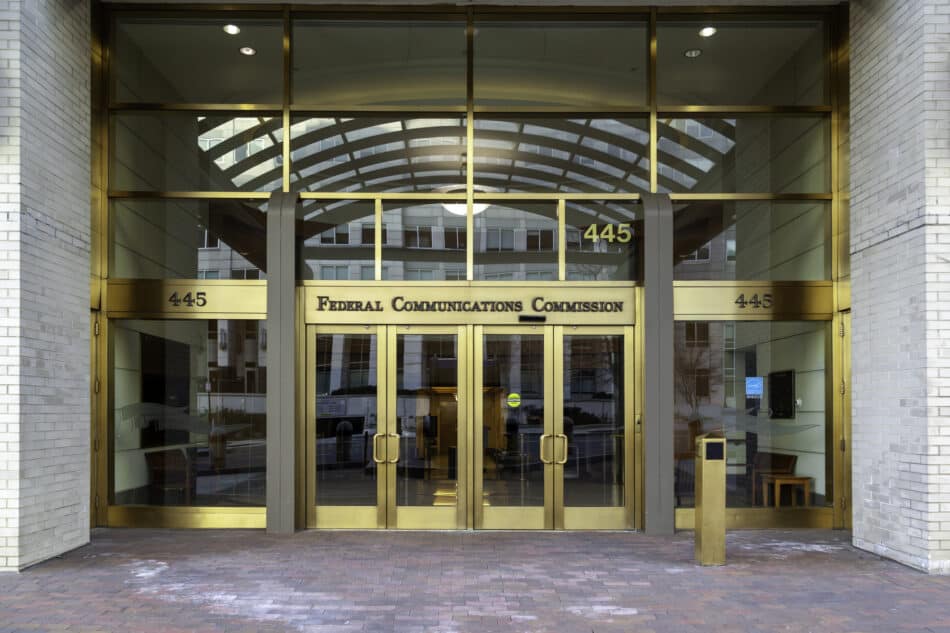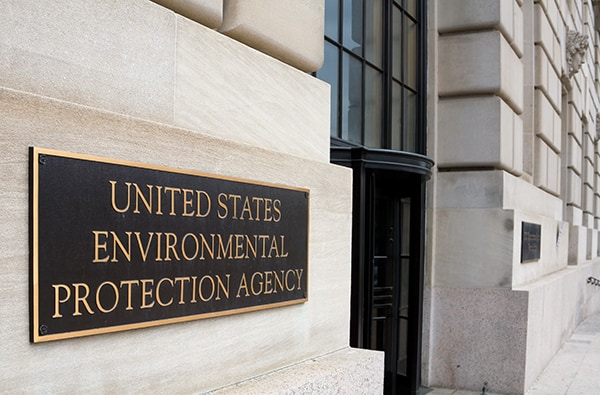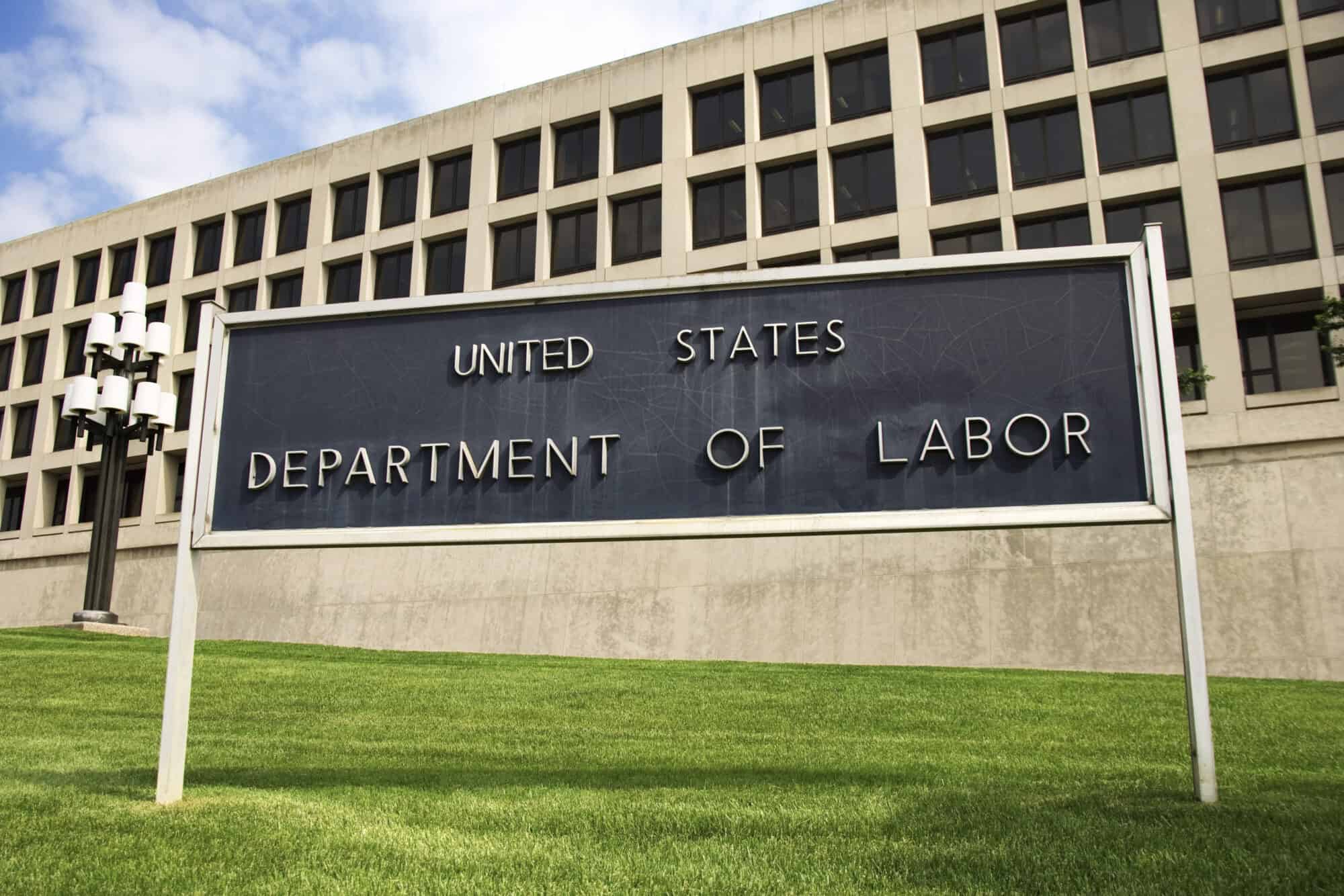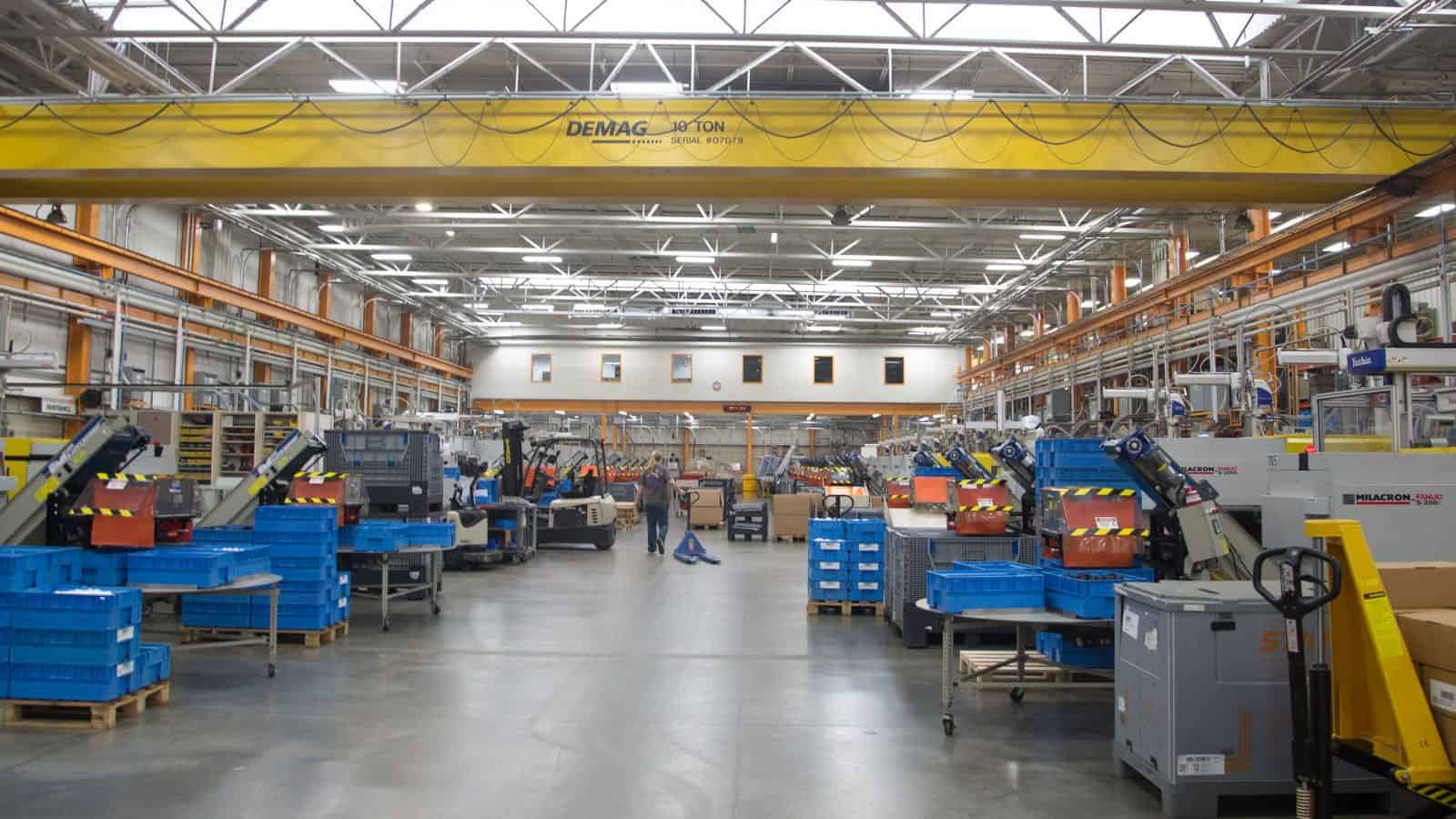NAM: EPA’s National PFAS Drinking Water Standard Threatens Manufacturing

Municipal water systems will soon be required to remove six types of per- and polyfluoroalkyl substances, or PFAS, from drinking water, The New York Times (subscription) reports.
- But the move could backfire and have adverse effects on manufacturers, the NAM said Thursday.
What’s going on: The Environmental Protection Agency on Wednesday announced the first-ever national rule limiting PFAS “to near-zero levels.”
- PFAS are compounds that have been used for decades due to their rare ability to douse fires and resist grease, corrosion and stains. They’re found in everything from semiconductors to medical devices and renewable-energy production equipment.
- But under the new mandate water systems across the U.S. will have three years to monitor the chemicals and a further two years to put into place technology to reduce the compounds’ levels in the water.
- The utilities “would be required to notify the public and reduce contamination if levels exceeded the new standard of 4 parts per trillion for [PFOA and PFOS]. Previously, the agency had advised that drinking water contain no more than 70 parts per trillion of the chemicals.”
The background: The rule comes just over a year after the EPA proposed the first federal limits on two PFAS chemicals, known as PFOA and PFOS.
The funding: The 2021 Bipartisan Infrastructure Law set aside $9 billion to help communities with PFAS removal. The government will make $1 billion of it available to states and territories to help defray the cost of testing and treatment over the next few years.
Higher prices, less security: The new standard is wholly infeasible, NAM Managing Vice President of Policy Chris Netram said, and will lead to cost increases throughout the supply chain and make our national defense more difficult.
- “In many instances, there is no viable alternative for these chemicals, and companies may be forced to change plans dramatically” to comply with the new rule, he said. “The severity of the proposed regulations will mean higher prices for everything—community water and waste systems, medical treatments and electronics. More alarming, the regulations will make it more difficult to produce the equipment our military needs to defend our nation.”
What we’re doing: The NAM is weighing legal options for reversing the final rule, according to Netram.
Senate Approves NLRB “Joint Employer” Repeal Proposal

The Senate this week approved a resolution to repeal the National Labor Relations Board joint employer rule, Reuters (subscription) reports.
What’s going on: In a 50–48 vote Wednesday, the Democrat-controlled Senate passed a Congressional Review Act resolution to block an NLRB “rule that would treat companies as the employers of many of their contract and franchise workers and require them to bargain with those workers’ unions.”
- President Biden pledged to veto the resolution, which the House approved in January. A veto would send the measure back to Congress, where it appears to lack the necessary votes for an override.
- The CRA “allows Congress to repeal agency rules through a majority vote in both houses.” The president must sign the resolution for it to take effect.
- The rule was scheduled to go into effect in February but was blocked by a federal judge in Texas. The NLRB is considering options in response to the decision.
What it would do: “The rule would treat companies as ‘joint employers’ of contract and franchise workers when they have control over key working conditions such as pay, scheduling, discipline and supervision, even if that control is indirect or not exercised.”
Why it would be problematic: The NLRB requirement would lead to confusion about which businesses should be considered employers, “disrupting franchising and routine contracting arrangements,” according to another Reuters article.
The NAM says: The joint employer rule would “harm manufacturers at a time when they need the flexibility and contingency offered through temporary and contract workers to best manage supply chain impacts, demand for manufactured products and other inflationary challenges,” the NAM told the NLRB in December.
Manufacturers: EPA Chemical Decision Will Directly Threaten Our Ability to Innovate, Create Jobs and Defend Our Nation
Washington, D.C. – Following the release of the Environmental Protection Agency’s rulemaking surrounding the monitoring for per- and poly-fluoroalkyl substances (PFAS) in municipal water systems, National Association of Manufacturers Managing Vice President of Policy Chris Netram released the following statement:
“Manufacturers support efforts to remove potentially harmful chemicals from our water systems, but again the EPA has set standards that are not feasible and will directly threaten manufacturers’ ability to invest, innovate and create jobs in America. In many instances, there is no viable alternative for these chemicals, and companies may be forced to change plans dramatically to grow facilities and hire new workers.
“The severity of the proposed regulations will mean higher prices for everything—community water and waste systems, medical treatments and electronics. More alarming, the regulations will make it more difficult to produce the equipment our military needs to defend our nation. The final rule requires water systems to monitor, sample and treat at near zero levels, which will increase costs throughout the supply chain. We are looking at all options to reverse this harmful decision and to slow the regulatory onslaught that directly undermines the president’s efforts to grow manufacturing in the United States.”
-NAM-
The National Association of Manufacturers is the largest manufacturing association in the United States, representing small and large manufacturers in every industrial sector and in all 50 states. Manufacturing employs nearly 13 million men and women, contributes $2.89 trillion to the U.S. economy annually and accounts for 53% of private-sector research and development. The NAM is the powerful voice of the manufacturing community and the leading advocate for a policy agenda that helps manufacturers compete in the global economy and create jobs across the United States. For more information about the NAM or to follow us on Twitter and Facebook, please visit www.nam.org.
NAM: Ethylene Oxide Rule Needs Revision

A newly finalized rule from the EPA will require chemical and plastics plants to slash emissions of two widely used compounds, according to The Wall Street Journal (subscription).
What’s going on: The EPA’s final rule, released Tuesday, requires manufacturing facilities to curb emissions of chemicals including ethylene oxide and chloroprene. These two chemicals have broad applications, from sterilizing medical equipment to producing synthetic rubber.
- The rule would affect about 200 plants across the U.S. and include a requirement for “fenceline monitoring,” the use of technology to measure the ambient air concentration for certain chemicals.
- Once in effect, the regulation could reduce emissions of both compounds by almost 80% annually, the EPA said.
The background: The news comes less than a month after the EPA finalized a rule to regulate the use of ethylene oxide as a sterilizing agent, a decision that will affect the way most medical devices—including complex, lifesaving ones, such as artificial heart valves—are sterilized.
Regulatory onslaught continues: “While the EPA listened to some of manufacturers’ concerns, such as allowing more time for companies throughout the supply chain to assess the impact on their operations, the rulemaking adds to the ongoing regulatory onslaught our industry has been facing,” said NAM Managing Vice President of Policy Chris Netram.
Effect on supply chains: The fenceline monitoring schedule will be a “significant burden” to manufacturers, as will the EPA’s requirement that operations be fully shut down for small plant repairs, Netram continued.
- “The potential disruption to supply chains could make it more difficult to create jobs in communities across the country.”
Manufacturers Bracing for FCC Vote on Broadband Regulation Rule

The Federal Communications Commission is set for an April 25 vote to bring back “net neutrality,” aiming to reinstate a national regulatory framework for broadband internet services, Fox Business reports. The NAM is speaking out against it.
What is it: “The Biden administration’s rule would regulate broadband services as an essential resource under Title II of the Communications Act.’’
How did we get here: “In 2015, the FCC adopted the Obama administration’s [net] neutrality rules, known as the Open Internet Order. The rules survived a legal challenge with a favorable ruling by a federal appeals court in 2016.”
- In 2017, the Trump administration rolled back broadband regulation with a regulation known as the Restoring Internet Freedom rule, citing it as an impediment to innovation and investment by internet service providers. This decision held up against a legal challenge.
- By 2021, President Biden’s executive order suggested reviving Obama-era broadband rules. With Democrats leading the FCC by October 2023, a formal process began, setting the stage for a conclusive vote.
What would happen next: The NAM sent detailed feedback to the FCC last December, warning that reinstating broadband regulation “will lead to a slowdown in innovation and investment.”
- The NAM’s feedback pointed to the negative impact of the Obama administration’s previous attempt to implement the policy: “In 2015, the last time the FCC sought to regulate broadband under Title II, annual industry capex fell by half a billion dollars.”
- The FCC’s decision exceeds its authority and could also be subject to litigation: “Congress has not explicitly given the commission the authority to regulate broadband and reclassify it in this way; therefore, the FCC lacks authority to do so.”
Our take: “As with the other elements of the regulatory onslaught out of Washington these past few years, this is yet another solution in search of a problem, because we already have an open and fair internet,” said NAM Senior Director of Technology Policy Franck Journoud. “As we’ve warned, this will regulate broadband as if it were the same as rotary telephone service, which would slow innovation. The commission really is doing nothing to answer the question of ‘why’ this policy should be brought back.”
- The NAM has long opposed broadband regulation and went to court to support the FCC’s 2017 decision to repeal the rule. As NAM Chief Legal Officer Linda Kelly said, “Internet-driven technology is at the heart of modern manufacturing, and the FCC’s decision to repeal the onerous 2015 net neutrality rule was a victory for the competitiveness of manufacturers in America.”
The NAM will closely follow the FCC’s latest vote on net neutrality and is prepared to oppose any decision to restore this outdated policy.
TSMC to Receive Up to $6.6 Billion in CHIPS Funding

The Biden administration on Monday announced that TSMC’s Arizona subsidiary will receive up to $6.6 billion in grants from the 2022 CHIPS and Science Act, The New York Times reports. The announcement is the latest move by the Biden administration to make the United States a leading producer of cutting-edge semiconductor technology.
What’s going on: The funding “will help support the construction of TSMC’s first major U.S. hub, in Phoenix. The company has already committed to building two plants at the site and will use some of the grant money to build a third factory in Phoenix, U.S. officials said on Sunday.”
- The company will “increase its total investments in the United States to more than $65 billion, up from $40 billion.”
- “TSMC’s investment is expected to create about 6,000 direct manufacturing jobs and more than 20,000 construction jobs, federal officials said.”
- In addition to the grants, the federal government is also offering TSMC up to $5 billion in loans.
Impact on U.S. chip production: “With projects such as TSMC’s, the U.S. is on track to make about 20% of the world’s cutting-edge chips by 2030, the Commerce Department said. It called the project the largest foreign direct investment in a new project in U.S. history,” reports The Wall Street Journal (subscription).
- Earlier this year, the Biden administration announced major chips funding awards for Intel and GlobalFoundries.
The NAM’s reaction: “Today’s announcement from TSMC and @CommerceGov makes America stronger,” the NAM wrote in a social post Monday. “The NAM-championed CHIPS and Science Act continues to spur new investments in cutting-edge semiconductor technology that is essential to advancing U.S. economic competitiveness.”
Final Heavy-Duty Tailpipe Rule Presents Challenges

The Environmental Protection Agency’s new heavy-duty tailpipe emissions rule is unrealistic and unfeasible, the NAM said Friday.
What’s going on: “The rule—proposed in April 2023—is part of the ‘Clean Trucks Plan’ unveiled in 2023, which includes light-duty tailpipe and nitrogen oxide rules,” Bloomberg Law (subscription) reports.
- “The[se] ‘Phase 3’ standards build on previous phases of a broader regulatory program to stem greenhouse gas emissions from vehicles such as delivery trucks, long-haulers, and buses.”
- The Phase 1 rule was finalized in 2011, and the Phase 2 rule in 2016.
Why it’s problematic: While the new regulation grants automakers more time for implementation than previous versions did—thanks to input from manufacturers and their advocates, including the NAM—it still “fails to reconcile with the realities of current U.S. infrastructure,” according to an NAM social post.
- “Critical permitting reforms to strengthen transmission systems and a technology-neutral approach for manufacturers are essential to reaching U.S. climate goals,” the NAM wrote.
What should be done: Congress must reform the broken U.S. permitting system so we can build the electric vehicle charging station infrastructure required to implement a rule of this magnitude, the NAM said earlier this month.
NAM: OSHA “Walkaround” Rule an Example of Regulatory Onslaught

The U.S. Occupational Safety and Health Administration’s newly finalized “walkaround rule” is unlawful and will not further the agency’s mission of ensuring safe working conditions, the NAM said after the rule’s release.
What’s going on: The long-awaited final rule, which goes into effect May 31, states that “workers may authorize another employee to serve as their representative or select a non-employee,” according to the Department of Labor.
- The policy broadens the basis upon which a non-employee representative may be deemed “reasonably necessary to the conduct of an effective and thorough inspection.”
Why it’s problematic: In addition to having little to do with making workplaces safer, the new policy violates OSHA’s own mandate—and, quite possibly, manufacturers’ constitutional rights, the NAM said.
- The “rule does nothing to advance OSHA’s mission of ensuring safe working conditions,” said NAM Chief Legal Officer Linda Kelly. “Forcing businesses to accommodate third parties with no safety expertise in their facilities infringes on employers’ property rights, invites new liabilities and introduces elements of chaos and disruption to safety inspections. … [It also] clearly violates OSHA’s statutory mandate to conduct inspections within ‘reasonable limits and in a reasonable manner’ with ‘minimum burden’ on employers, and potentially violates manufacturers’ constitutional rights.”
Next steps: The NAM is weighing legal action to reverse the final rule.
Manufacturers: Walkaround Rule Exceeds OSHA’s Authority
Washington, D.C.: Following the release of the Occupational Safety and Health Administration’s recent rulemaking on the Worker Walkaround Representative Designation Process, National Association of Manufacturers Chief Legal Officer Linda Kelly released the following statement:
“Today’s rule does nothing to advance OSHA’s mission of ensuring safe working conditions. Forcing businesses to accommodate third parties with no safety expertise in their facilities infringes on employers’ property rights, invites new liabilities and introduces elements of chaos and disruption to safety inspections.
“By unlawfully expanding third-party access to manufacturers’ worksites, this proposal clearly violates OSHA’s statutory mandate to conduct inspections within ‘reasonable limits and in a reasonable manner’ with ‘minimum burden’ on employers, and potentially violates manufacturers’ constitutional rights. And, for the first time, OSHA would determine who qualifies as an ‘authorized representative’ of employees, which until now has been exclusively recognized as the jurisdiction of the National Labor Relations Board.
“This is another clear example of the federal regulatory onslaught—a proposal that upends settled precedent and ignores the reasoned decision-making required by the Administrative Procedure Act. For these reasons, the NAM will be considering legal action to reverse this incredibly destabilizing decision.”
-NAM-
The National Association of Manufacturers is the largest manufacturing association in the United States, representing small and large manufacturers in every industrial sector and in all 50 states. Manufacturing employs nearly 13 million men and women, contributes $2.85 trillion to the U.S. economy annually and accounts for 53% of private-sector research and development. The NAM is the powerful voice of the manufacturing community and the leading advocate for a policy agenda that helps manufacturers compete in the global economy and create jobs across the United States. For more information about the NAM or to follow us on Twitter and Facebook, please visit www.nam.org.
Group Urges Ratification of Deep-Sea Mining Treaty

A group of former political and military leaders is urging the Senate to ratify the United Nations’ Convention of the Law of the Sea to kickstart U.S. deep-sea mining efforts, The Wall Street Journal (subscription) reports.
What’s going on: A draft letter seen by the Journal and signed by 331 individuals, including former Secretary of State Hillary Clinton and former Secretary of Homeland Security Michael Chertoff, calls “on Senate leaders to ratify the treaty in a bid for the country to stake its claim over areas of international waters where minerals such as cobalt and nickel, considered critical for the energy transition and in defense applications, can be sourced.”
- The treaty, which the U.S. recognized after it went into effect in 1994 but never ratified, is an international agreement governing the use of ocean resources.
Why it’s important: The treaty’s governing body, the International Seabed Authority, meets next week in Jamaica to determine “the final parts of the mining code—the set of laws and regulations that will eventually govern seabed mining. … As a nonvoting member, the U.S. has no say on laws pertaining to the seabed and also can’t be awarded exploration contracts to mine the seafloor in international waters. China currently has five.”
A groundswell: Deep-sea mining is gaining political support.
- Earlier this month, Reps. Carol Miller (R-WV) and John Joyce (R-PA) introduced a measure in support of it.
- “It’s vital to our security and economic interests that the [China]-controlled monopoly on these materials is broken,” Rep. Joyce said.
